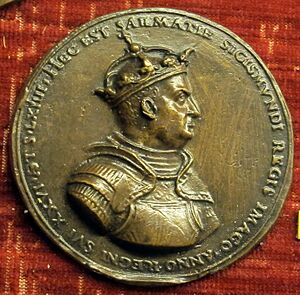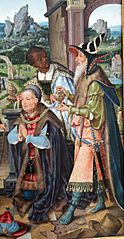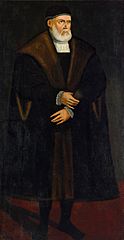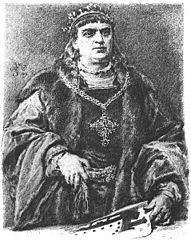Sigismund I the Old facts for kids
Quick facts for kids Sigismund I the Old |
|
|---|---|

Portrait by Kulmbach, 1511-1518
|
|
| King of Poland Grand Duke of Lithuania |
|
| Reign | 8 December 1506 – 1 April 1548 |
| Coronation | 24 January 1507 in Wawel Cathedral, Kraków |
| Predecessor | Alexander I |
| Successor | Sigismund II Augustus |
| Born | 1 January 1467 Kozienice, Poland |
| Died | 1 April 1548 (aged 81) Kraków, Poland |
| Burial | 7 July 1548 Wawel Cathedral, Kraków |
| Spouse | |
| Issue more... |
|
| Dynasty | Jagiellon |
| Father | Casimir IV of Poland |
| Mother | Elisabeth of Austria |
| Religion | Roman Catholic |
| Signature | |
Sigismund I the Old (Polish: Zygmunt I Stary, Lithuanian: Žygimantas II Senasis; born January 1, 1467 – died April 1, 1548) was the King of Poland and Grand Duke of Lithuania. He ruled from 1506 until his death in 1548. Sigismund I was part of the Jagiellonian dynasty. He was the son of Casimir IV and the younger brother of Kings John I Albert and Alexander I Jagiellon. People called him "the Old" later in history to tell him apart from his son, Sigismund II Augustus.
Sigismund was born in Kozienice in 1467. He was the fifth son of Casimir IV and Elizabeth of Austria. He was one of thirteen children. It was not expected that he would become king after his father. His oldest brother, Vladislaus II, became King of Bohemia, Hungary, and Croatia. This united these kingdoms for a time. When Casimir died, the Polish-Lithuanian lands were split between his two older sons. John Albert became King of Poland, and Alexander became Grand Duke of Lithuania. Alexander then inherited Poland after John Albert's sudden death in 1501. Sigismund became king and grand duke in 1506 when he was 39 years old.
Sigismund was a good ruler and supported the arts. He brought Ducal Prussia under Polish rule. He also added the Duchy of Mazovia (with Warsaw) to Poland. He made sure Poland stayed rich and important in the region. He made his nephew, Albert, Duke of Prussia, and Albert's Protestant followers, pay tribute to Polish kings. This showed that Prussia depended on Poland. This continued until 1657. Sigismund and his general, Jan Amor Tarnowski, also defeated Moldavia in 1531 and Muscovy in 1535. This made Poland's eastern borders stronger. His 42-year rule also saw big changes in Polish architecture, food, language, and customs. This was especially true because of his second wife, Bona Sforza, who was from Italy. Italian styles became popular during the Polish Renaissance and Polish Golden Age. This time helped shape Poland's Roman Catholic identity. Sigismund was honored on a 200-złoty banknote.
Sigismund married twice. First, he married Barbara Zápolya from Hungary. Then, he married Bona Sforza, daughter of Gian Galeazzo Sforza, Duke of Milan. Their only son, Sigismund Augustus, was crowned king while his father was still alive in 1529. He officially became king when Sigismund the Old died in 1548.
Contents
Early Life and Becoming King
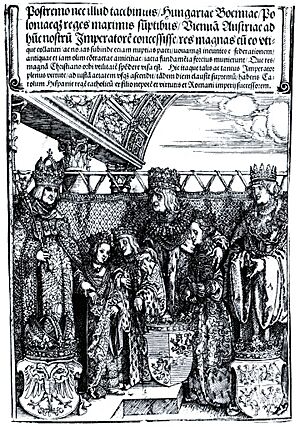
Sigismund was the son of King Casimir IV Jagiellon and Elisabeth Habsburg of Austria. He followed his brothers John Albert and Alexander to the Polish throne. Their oldest brother, Vladislaus, became king of Bohemia, Hungary, and Croatia. Sigismund was named after his mother's great-grandfather, Holy Roman Emperor Sigismund.
When Casimir died in 1492, Sigismund was the only son without any land or titles. From 1495 to 1496, he asked his brother Alexander for land. His mother, Elisabeth Habsburg, also tried to get him on the Austrian throne. Both attempts failed. In 1497, his older brother, King John I Albert, led an invasion of Moldavia. The goal was to make Sigismund its king. This plan also failed badly. Finally, his oldest brother, Vladislaus II, King of Bohemia and Hungary, gave him the duchies of Głogów (1499) and Opava (1501). In 1504, Sigismund became governor of Silesia and Lower Lusatia.
John I Albert died suddenly in 1501. Alexander I became king after him, but then Alexander died in 1506. After Alexander's death, Sigismund went to Vilnius. There, the Lithuanian Ducal Council chose him as Grand Duke of Lithuania on September 13, 1506. This was against an earlier agreement from 1501. On December 8, 1506, Sigismund was chosen King of Poland in Piotrków. He arrived in Kraków on January 20, 1507. Four days later, he was crowned in Wawel Cathedral.
Poland's Internal Affairs
Governing the Kingdom
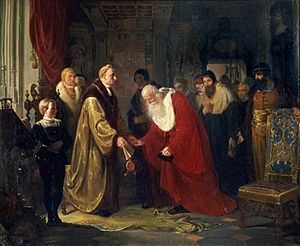
In Poland, the power of the Chamber of Deputies was very strong. A law called Nihil novi made this even clearer. This law said that Polish kings could not make new laws without the agreement of the Sejm (parliament). Sigismund had little control over this law. However, he did appoint the senators. During his rule, Sigismund listened to advice from local nobles. He also had skilled ministers who managed the royal courts. The rich treasurers of Kraków also helped him.
Even though he didn't like the parliament system, he respected the laws. He held yearly meetings of the Sejm. He usually got money for national defense. But he could not create a permanent fund for defense from taxes. Still, in 1527, he created a conscript army. He also set up the offices needed to pay for it. He made laws that made serfdom official in Poland. This meant peasants worked on nobles' private lands.
Sigismund I had many economic successes. He reduced some of the country's debt. He separated public tax money from the royal treasury. He also made the mint in Kraków work better. He tried to organize the money from salt mines. In 1519, he issued a law for the Armenians. He also wanted to make the legal system the same across the country.
Between 1530 and 1538, the king made two laws about how the next king would be chosen. These laws made sure that kings would always be elected. They said that everyone, no matter how rich, could watch the election. The election had to be free. Sigismund also did a good job managing farming. He helped royal cities grow. He got back many royal properties that had been rented out. His wife, Queen Bona, strongly supported him in financial matters. She wanted to expand royal lands and make them more profitable.
The Chicken War Rebellion
When Sigismund I became king, Poland had a long history of noble freedoms. These freedoms were confirmed by many special rights. A rebellion in Lwów happened in 1537. It was called the Chicken War (Polish: Wojna kokosza). This was a revolt by Polish nobles against the king's power. The name "Chicken War" was made up by the nobles who supported the king. They said the only result of the "war" was that the local chickens were eaten by the nobles gathered for the rebellion.
To make his power stronger, Sigismund started some reforms. In 1527, he created a permanent army. He also expanded the government offices needed to run the country and pay for the army. His Italian wife, Bona Sforza, supported him. He began buying land and making farming reforms to increase the royal treasury. He also started getting back royal properties that had been pawned or rented to nobles.
The nobles gathered near Lwów for a military campaign against Moldavia. However, the lesser and middle nobles used this gathering to revolt. They wanted to force the King to stop his risky reforms. The nobles made 36 demands. Most importantly, they wanted Queen Bona to stop buying land. They also wanted nobles to be free from the tithe (a tax). They wanted their privileges confirmed and expanded. They also wanted a law called Incompatibilitas. This law would stop one person from holding two or more important government jobs. This was meant to prevent rich magnates from getting too much power.
But the revolt soon showed that the noble leaders were divided. It was almost impossible to reach an agreement. The protesters were too weak to start a civil war against the King. So, they agreed to a compromise. Sigismund rejected most of their demands. But he did accept the idea of Incompatibilitas the next year. He also agreed not to force the election of the next king while he was still alive. After this, the nobles went home, having achieved little.
Poland's Foreign Relations
Wars with Muscovy
Sigismund was often at war with Vasili III of Muscovy. This started in 1507. Tensions grew when Vasili found out Sigismund was paying Khan Meñli I Giray to attack Muscovy. In December 1512, Muscovite forces marched into Lithuania. They wanted to capture Smolensk, an important trading city. Their first attempts in 1513 failed. But the city fell to Muscovy in July 1514.
Russia then suffered many big defeats in battles. In 1512, Grand Hetman of Lithuania, Konstanty Ostrogski, attacked the region of Severia. He defeated a Russian force of about 6,000 men. On September 8, 1514, Muscovy lost badly at the Battle of Orsha. This stopped the Russians from taking all the former Kievan Rus lands. Poland used this battle for propaganda against Russia. A letter sent to Rome said that "Muscovites are not Christians; they are cruel and barbaric; they are Asians and not Europeans; they are in league with Turks and the Tatars to destroy Christendom".
Even with this victory, the Polish–Lithuanian troops could not move fast enough to retake Smolensk. In 1518, Russian forces were beaten again during the siege of Polotsk. A legend says Lithuanian forces were inspired by their patron saint, Saint Casimir, Sigismund's older brother. But historians say this is just a folk tale. In 1522, Lithuania and Muscovy signed a truce that lasted until 1534.
In 1534, Grand Hetman Jerzy Radziwiłł and the Tatars attacked western Russia. In return, the Muscovites invaded Lithuania again. They were stopped by Polish commander Jan Amor Tarnowski and his allies at Starodub in 1535. This defeat strengthened the Polish-Lithuanian union's eastern side. This lasted until the Livonian War began in 1558.
Alliances in Europe
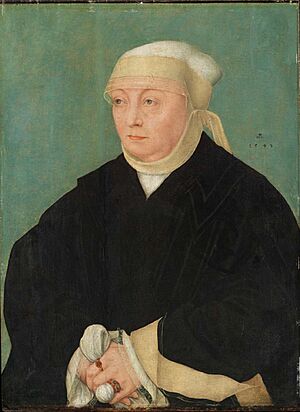
In 1515, Sigismund made an alliance with the Holy Roman Emperor Maximilian I. Maximilian agreed to support the Second Peace of Thorn (1466). In return, Sigismund agreed to the marriage of his brother Vladislaus II of Bohemia and Hungary's children to Maximilian's grandchildren. Because of these marriages, Bohemia and Hungary passed to the Habsburg family in 1526. This happened after Sigismund's nephew, Louis II, died fighting the Ottoman Empire at the Battle of Mohács.
Sigismund was worried about the growing ties between the Habsburgs and Russia. So, in 1524, he signed a Franco-Polish alliance with King Francis I of France. This was to avoid a possible war on two fronts. Francis I also wanted allies in Central Europe. He wanted to limit the growing power of Habsburg Emperor Charles V. Queen Bona also helped set up this alliance. She wanted to get Milan back for Poland.
These talks ended when Francis's troops were defeated by Charles V at the Battle of Pavia in 1525. Francis then turned to Hungary. He formed an alliance with King John Zápolya in 1528.
After Janusz III of Masovia died in 1526, Sigismund successfully united the Duchy of Masovia and Warsaw with Poland. There were rumors that Janusz and his younger brother Stanisław were poisoned by someone working for Queen Bona. These accusations were so strong that Sigismund ordered an investigation. On February 9, 1528, a special law was declared. It confirmed that the Masovian princes died naturally or from illness.
Sigismund also tried to live peacefully with the Khanate of Crimea. But he could not completely stop border fights.
Teutonic Knights
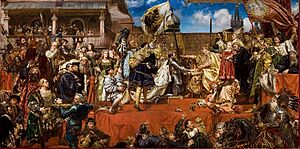
More than two centuries of wars against the Teutonic Knights ended in 1525. This happened with the Treaty of Kraków after the final Polish–Teutonic War (1519–1521). Before this, the Second Peace of Thorn (1466) had placed the Teutonic Order under Polish rule. The Order tried to avoid paying tribute to Polish kings. This showed their weakness and dependence.
According to the new Treaty of Kraków, the Order became secular. It became a puppet state of Poland. This lasted until the Treaty of Bromberg in 1655. Sigismund's nephew, Albert, Duke of Prussia, became a Lutheran after talking with Martin Luther. He then paid a feudal homage to Sigismund. In return, he was given the Order's lands as the First Duke of Prussia. This event is known as the "Prussian Homage" in Polish and Lithuanian history. It is often shown in art. The Prussian parliament met in Königsberg. There, envoys welcomed the new Duke and the Protestant Reformation. After this, the Teutonic Order lost its importance as a military order in Prussia. It moved back to the Holy Roman Empire.
Renaissance and Sigismund's Legacy

Sigismund was very interested in the Renaissance and old classical ideas. His second wife, Bona Sforza, also helped a lot. She was the daughter of Gian Galeazzo Sforza from Milan. She brought famous Italian artists, architects, and sculptors from her home country. It was during Sigismund's rule that the Renaissance began to grow in Poland and Lithuania. His son, Sigismund II Augustus, later continued his father's work.
Many famous people visited or lived in Poland at this time. These included Bartholommeo Berecci, Francesco Fiorentino, Santi and Mateo Gucci, Bernardo Morando, Giovanni Battista di Quadro, and Hans Dürer. Most of the artists working for the royal court were foreigners. Italians and Germans especially had a big impact on Poland's architecture. The most important example of their work is Wawel Castle in Kraków. This was the home of Polish kings. It is one of the largest castles in Central Europe. The castle was rebuilt in the Renaissance style to fit the royal family's needs. The Italian courtyard, corridors, arches, and doorways were designed by Fiorentino. A similar design was used for Niepołomice Castle, which was a hunting lodge for the Jagiellons.

The most famous example of Sigismund's building projects is a funeral chapel at Wawel Cathedral. It was built between 1519 and 1533. It followed plans by Bartolomeo Berrecci from Florence. It serves as a mausoleum for the last Jagiellon kings. The outside dome is covered in gold. The tombs inside are made of marble and designed by Santi Gucci. Experts say the chapel is "the most beautiful example of the Tuscan Renaissance north of the Alps." The king also ordered a huge 12.6-tonne bell. It was named in his honor. The Royal Sigismund Bell was put in Wawel Cathedral's northern tower on July 13, 1521. Besides religious and national holidays, the bell rings during important moments in Polish history. It is one of Poland's national symbols.
Death and Who Came Next
Sigismund had many illnesses, especially later in his life. He often had fevers since he was young. In 1528, he suffered from gout and severe rheumatism. This condition affected his joints and right leg. It kept coming back in 1529 and 1534. It is likely that Sigismund Augustus was crowned king in 1529 because his father was in so much pain. This was in case his father died suddenly. Also, bad eating habits, like drinking a lot of beer and mead, made the king's health worse. Eventually, the king could not walk and had to be carried in a litter. However, even at his old age, Sigismund remained clear-minded. He stayed active in politics until he died. In 1543, he recovered from the influenza that spread in Kraków. In 1545, he went on a last hunting trip to Niepołomice.
Sigismund died on April 1, 1548, at the age of 81. He was buried on July 7 at Wawel Cathedral in Kraków. His only legitimate son, Sigismund II Augustus, became king after him. He was the last Jagiellon king of Poland and Grand Duke of Lithuania. In 1587, Sigismund the Old's grandson, Sigismund III from the House of Vasa, was elected King of Poland. He was the son of Catherine Jagiellon and John III Vasa of Sweden. So, Sigismund III was not a Jagiellon through his mother. But the Jagiellon bloodline of Polish monarchs continued until the death of Sigismund Vasa's second son, John II Casimir.
Portraits and Art
- Depictions of Sigismund I in art
-
As one of the Magi by Joos van Cleve, c. 1520
-
Sigismund I the Old by Jan Matejko, c. 1880
Marriages and Children
In 1512, Sigismund married Barbara Zápolya (died 1515), a Hungarian noblewoman. They had two daughters:
- Electress Hedwig of Brandenburg (March 15, 1513 – February 7, 1573). She married Joachim II Hector, Elector of Brandenburg in 1535.
- Anna (July 1, 1515 – May 8, 1520).
In 1517, Sigismund married Bona Sforza. They had two sons and four daughters:
- Queen Isabella of Hungary (January 18, 1519 – September 15, 1559). She married John Zápolya in 1539.
- Sigismund II Augustus (August 1, 1520 – July 7, 1572).
- Sophia, Duchess of Brunswick-Lüneburg (July 13, 1522 – May 28, 1575). She married Henry V, Duke of Brunswick-Lüneberg, in 1556.
- Queen Anna of Poland (October 18, 1523 – September 9, 1596). She married Stephen Báthory in 1576.
- Queen Catherine of Sweden (November 1, 1526 – September 16, 1583). She married John, Duke of Finland (later John III of Sweden), in 1562.
- Wojciech Olbracht (born and died September 20, 1527).
Before his first marriage, he had three children with his mistress, Katarzyna Telniczanka (died 1528):
- Jan (January 8, 1499 – February 18, 1538). He was Bishop of Wilno (1519–1536) and of Poznań (1536–1538).
- Regina (1500/1 – May 20, 1526). She married Hieronim Szafraniec, Starost of Cieszyn, around October 20, 1518.
- Katarzyna (1503 – before September 9, 1548). She married George II Count von Montfort in Pfannberg after 1522.
See also
 In Spanish: Segismundo I Jagellón el Viejo para niños
In Spanish: Segismundo I Jagellón el Viejo para niños
- History of Poland (1385–1569)
- Zygmunt (bell)
- List of Polish monarchs


